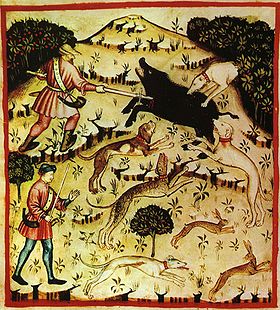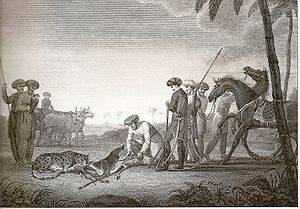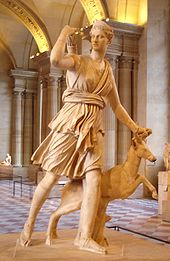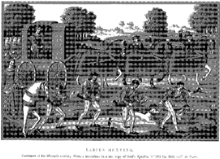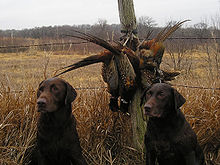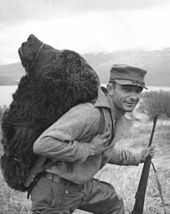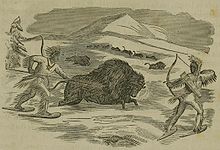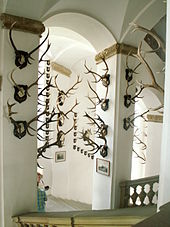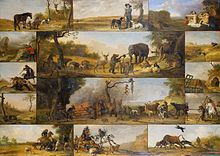- Hunting
-
Hunting is the practice of pursuing any living thing, usually wildlife, for food, recreation, or trade. In present-day use, the term refers to lawful hunting, as distinguished from poaching, which is the killing, trapping or capture of the hunted species contrary to applicable law. The species which are hunted are referred to as game, and are usually mammals and migratory or non-migratory gamebirds.
Hunting can also involve the elimination of vermin, as a means of pest control to prevent diseases caused by overpopulation. Hunting advocates state that hunting can be a necessary component[1] of modern wildlife management, for example to help maintain a population of healthy animals within an environment's ecological carrying capacity when natural checks such as predators are absent.[2] In the United States, wildlife managers are frequently part of hunting regulatory and licensing bodies, where they help to set rules on the number, manner and conditions in which game may be hunted.
The pursuit, capture and release, or capture for food of fish is called fishing, which is not commonly categorised as a form of hunting. Trapping is also usually considered a separate activity. It is also not considered hunting to pursue animals without intent to kill them, as in wildlife photography or birdwatching. The practice of hunting for plants or mushrooms is a colloquial term for foraging or gathering.
Skilful tracking and acquisition of an elusive target has caused the word hunting to be used in the vernacular as a metaphor, as in "bargain hunting" or "hunting down corruption and waste".
Contents
History
Paleolithic
Hunting has a long history and may well pre-date the rise of the species Homo sapiens. While our earliest Hominid ancestors were probably frugivores or omnivores, there is evidence that earlier Homo species, and possibly also Australopithecine[3] species utilised larger animals for subsistence.
Furthermore there is evidence that hunting may have been one of the multiple environmental factors leading to extinctions of the holocene megafauna, and their replacement by smaller herbivores.[4] It has been found that the North American megafauna extinction was coincidental with the Younger Dryas impact event, possibly making hunting a less critical factor in prehistoric species loss than had been previously thought.[5] However, in other locations such as Australia, humans are thought to have played a very significant role in the extinction of the Australian megafauna that was widespread prior to human occupation.[6][7]
Of the closest surviving relatives of the human species, Pan, the Common Chimpanzee has an omnivorous diet, which includes troop hunting behaviour based on beta males being led by an alpha male, however the less violent Bonobos, have a mostly frugivorous diet.[8]
While it is undisputed that early humans were hunters, the importance of this for in the emergence of the Homo genus from the earlier Australopithecines, including the production of stone tools and eventually the control of fire, are emphasised in the hunting hypothesis, and de-emphasised in scenarios that stress omnivory and social interaction, including mating behaviour, as essential in the emergence of human behavioural modernity. With the establishment of language, culture, and religion, hunting became a theme of stories and myths, as well as rituals such as dance and animal sacrifice.
Hunting was a crucial component of hunter-gatherer societies before the domestication of livestock and the dawn of agriculture, beginning about 11,000 years ago. By the Mesolithic, hunting strategies had diversified with the development of the bow by 18,000 years ago and the domestication of the dog about 15,000 years ago. There is fossil evidence for spear use in Asian hunting dating from approximately 16,200 years ago.[9]
Many species of animals have been hunted throughout history. It has been suggested that in North America and Eurasia Caribou and wild reindeer "may well be the species of single greatest importance in the entire anthropological literature on hunting"[10] (see also Reindeer Age), although the varying importance of different species would depend on the geographic location.
Hunter-gathering lifestyles remained prevalent in some parts of the New World, Sub-Saharan Africa, and Siberia, as well as all of Australia, until the European Age of Discovery. They still persist in some tribal societies, albeit in rapid decline. Peoples that preserved paleolithic hunting-gathering until the recent past include some indigenous peoples of the Amazonas (Aché), some Central and Southern African Bushmen (Hadza people, Khoisan), some peoples of New Guinea (Fayu), the Mlabri of Thailand and Laos, the Vedda people of Sri Lanka, and a handful of uncontacted peoples.
Criticism
Archaeologist Louis Binford criticised the idea that early hominids and early humans were hunters. On the basis of the analysis of the skeletal remains of the consumed animals he concluded that hominids and early humans were mostly scavengers, not hunters,[11] and this idea is popular among some archaeologists and paleoanthropologists. Robert Blumenschine proposed the idea of confrontational scavenging,[12] which involves challenging and scaring off other predators after they have made a kill, which he suggests could have been the leading method of obtaining protein rich meat by early humans.
Antiquity
 Ancient Greek black-figure pottery depicting the return of a hunter and his dog. Made in Athens between 550-530 BCE, found in Rhodes.
Ancient Greek black-figure pottery depicting the return of a hunter and his dog. Made in Athens between 550-530 BCE, found in Rhodes.
Even as animal domestication became relatively widespread and after the development of agriculture, hunting was usually a significant contributor to the human food supply. The supplementary meat and materials from hunting included protein, bone for implements, sinew for cordage, fur, feathers, rawhide and leather used in clothing. Man's earliest hunting weapons would have included rocks, spears, the atlatl, and bow and arrows. Hunting is still vital in marginal climates, especially those unsuited for pastoral uses or agriculture.[citation needed] For example, Inuit people in the Arctic trap and hunt animals for clothing, and use the skins of sea mammals to make kayaks, clothing, and footwear.
On ancient reliefs, especially from Mesopotamia, kings are often depicted as hunters of big game such as lions, and are often portrayed hunting from a war chariot. The cultural and psychological importance of hunting in ancient societies is represented by deities such as the horned god Cernunnos, and lunar goddesses of classical antiquity, the Greek Artemis or Roman Diana. Taboos are often related to hunting, and mythological association of prey species with a divinity could be reflected in hunting restrictions such as a reserve surrounding a temple. Euripides' tale of Artemis and Actaeon, for example, may be seen as a caution against disrespect of prey, or impudent boasting.
With the domestication of the dog, birds of prey, and the ferret, various forms of animal-aided hunting developed including venery (scent hound hunting, such as fox hunting), coursing (sight hound hunting), falconry, and ferreting. While these are all associated with medieval hunting, over time various dog breeds were selected for very precise tasks during the hunt, reflected in such names as pointer and setter.
Pastoral and agricultural societies
Even as agriculture and animal husbandry became more prevalent, hunting often remained as a part of human culture where the environment and social conditions allowed. Hunting may be used to kill animals which prey upon domestic animals, or to attempt to extirpate animals seen by humans as competition for resources such as water or forage.
As hunting moved from a subsistence activity to a social one, two trends emerged. One was that of the specialist hunter with special training and equipment. The other was the emergence of hunting as a 'sport' for those of an upper social class. The meaning of the word "game" in middle English evolved to include an animal which is hunted. As game became more of a luxury than a necessity, the stylised pursuit of it also became a luxury. Dangerous hunting, such as for lions or wild boars, often done on horseback or from a chariot, had a function similar to tournaments and manly sports. Hunting was considered to be an honourable, somewhat competitive pastime to help the aristocracy practice skills of war in times of peace.
In most parts of medieval Europe, the upper class obtained the sole rights to hunt in certain areas of a feudal territory. Game in these areas was used as a source of food and furs, often provided via professional huntsmen, but it was also expected to provide a form of recreation for the aristocracy. The importance of this proprietary view of game can be seen in the Robin Hood legends, in which one of the primary charges against the outlaws is that they "hunt the King's deer". In the European medieval period, hunting was considered part of the set of seven mechanical arts.
Use of dogs
Although various animals have been used to aid the hunter, none has been as important as the dog.[citation needed] The domestication of the dog has led to a symbiotic relationship in which the dog has lost its evolutionary independence from humans in exchange for support.[citation needed]
Dogs today are used to find, chase, and retrieve game, and sometimes to kill it. Hunting dogs allow humans to pursue and kill prey that would otherwise be very difficult or dangerous to hunt. Different breeds of dogs are used for different types of hunting. Waterfowl are commonly hunted using retrieving dogs such as the Labrador Retriever, the Golden Retrievers, theChesapeake Bay Retriever, and others breeds similar.
Religion
Many prehistoric deities are either predators or prey of humans, often in a zoomorphic form, perhaps alluding to the importance of hunting for most Palaeolithic cultures.
In many pagan religions, specific rituals are conducted before or after a hunt; the rituals done may vary according to the species hunted or the season the hunt is taking place.[citation needed] Often a hunting ground, or the hunt for one or more species, was reserved or prohibited in the context of a temple cult.[citation needed]
Indian and Eastern religions
Hindu scriptures describe hunting as an acceptable occupation, as well as a sport of the kingly. Even figures considered godly are described to have engaged in hunting. One of the names of the god Shiva is Mrigavyadha, which translates as the deer hunter ("mriga" means deer, "vyadha" means hunter). In the epic Ramayana, Dasharatha, the father of Rama, is said to have the ability to hunt in the dark. During one of his hunting expedition he accidentally killed Shravana, mistaking him for game. During Rama's exile in the forest, Ravana kidnapped his wife Sita from their hut while Rama was hunting a golden deer, and his brother Lakshman went after him. According to the Mahabharat, Pandu, the father of the Pandavas, accidentally killed the sage Kindama and his wife with an arrow mistaking them for a deer. Krishna is said to have died after being accidentally wounded by an arrow of a hunter.
Jainism teaches followers to have tremendous respect for all of life. Prohibitions for hunting and meat eating are the fundamental conditions for being a Jain.
Buddhism's first precept is the respect for all sentient life. The general approach by all Buddhists is to avoid killing any living animals. Buddha explained the issue by saying "all fear death; comparing others with oneself, one should neither kill nor cause to kill".
Christianity, Judaism, and Islam
From early Christian times, hunting has been forbidden to Roman Catholic Church clerics. Thus the Corpus Juris Canonici (C. ii, X, De cleric. venat.) says "We forbid to all servants of God hunting and expeditions through the woods with hounds; and we also forbid them to keep hawks or falcons". The Fourth Council of the Lateran, held under Pope Innocent III, decreed (canon xv): "We interdict hunting or hawking to all clerics". The decree of the Council of Trent is worded more mildly: "Let clerics abstain from illicit hunting and hawking" (Sess. XXIV, De reform., c. xii), which seems to imply that not all hunting is illicit, and canonists generally make a distinction declaring noisy (clamorosa) hunting unlawful, but not quiet (quieta) hunting.
Ferraris (s.v. "Clericus", art. 6) gives it as the general sense of canonists that hunting is allowed to clerics if it be indulged in rarely and for sufficient cause, as necessity, utility or "honest" recreation, and with that moderation which is becoming to the ecclesiastical state. Ziegler, however (De episc., l. IV, c. xix), thinks that the interpretation of the canonists is not in accordance with the letter or spirit of the laws of the Church.
Nevertheless, although a distinction between lawful and unlawful hunting is undoubtedly permissible, it is certain that a bishop can absolutely prohibit all hunting to the clerics of his diocese, as was done by synods at Milan, Avignon, Liège, Cologne, and elsewhere. Benedict XIV (De synodo diœces., l. II, c. x) declared that such synodal decrees are not too severe, as an absolute prohibition of hunting is more conformable to the ecclesiastical law. In practice, therefore, the synodal statutes of various localities must be consulted to discover whether they allow quiet hunting or prohibit it altogether.
It is important to note that the Bible places no such restrictions on any Christian, as most do not observe kosher dietary laws. Hence Protestant clerics, Catholic lay parishioners, and Protestants have no religious restrictions on hunting. This is in accord with what is found in the book of Acts 15:28–29, and 1 Timothy 4:4.
Jewish hunting law, based on the Torah, is similar, permitting hunting of non-preying animals that are considered kosher for food, although hunting preying animals for food is strictly prohibited under Rabbinic law. Hence birds of prey are specifically prohibited and non-kosher. Hunting for sport, and not for food, is also forbidden in Rabbinical Law.
Islamic Sharia Law regarding hunting is the same as Jewish law, in that only non-preying animals that can be considered halal for food can be hunted, but only for food and not as blood-sport.[13]
National traditions
New Zealand
New Zealand has a strong hunting culture. The islands making up New Zealand originally had no land mammals apart from bats. However, once Europeans arrived game animals were introduced by acclimatisation societies to provide New Zealanders with sport and a hunting resource. Deer, pigs, goats, rabbits, tahr and chamois all adapted well to the New Zealand terrain, and with no natural predators their population exploded. Government agencies view the animals as pests due to their effects on the natural environment and on agricultural production, but hunters view them as a resource.
Shikar (India)
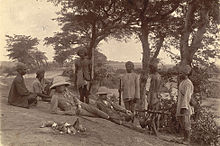 A Shikar party in Mandalay, Burma, soon after the conclusion of the Third Anglo-Burmese War in 1886 when Burma was annexed to British India
A Shikar party in Mandalay, Burma, soon after the conclusion of the Third Anglo-Burmese War in 1886 when Burma was annexed to British India
During the feudal and colonial times in India hunting was regarded as a wikt:regal sport in the numerous princely states, as many maharajas, nawabs, as well as British officers maintained a whole corps of shikaris, who were native professional hunters. They would be headed by a master of the hunt, who might be styled mir-shikar. Often these were recruited from the normally low-ranking local tribes because of their traditional knowledge of the environment and hunting techniques. Big game, such as Bengal tigers, might be hunted from the back of an elephant.
Indian social norms are generally antagonistic to hunting, while a few sects like the Bishnoi lay special emphasis on the conservation of particular species like the antelope. India's Wildlife Protection Act of 1972 bans the killing of all wild animals. However, the Chief Wildlife Warden may, if satisfied that any wild animal from a specified list has become dangerous to human life, or is so disabled or diseased as to be beyond recovery, permit any person to hunt such an animal. In this case the body of any wild animal killed or wounded becomes government property.[14]
Safari
A safari, from a Swahili word meaning a long journey, especially in Africa is defined as an overland journey.
Safari as a distinctive way of hunting was popularised by the US author Ernest Hemingway and President Theodore Roosevelt. A safari may consist of several days or even weeks-long journey, with camping in the bush or jungle, while pursuing big game. Nowadays, it's often used to describe tours through African national parks to watch or hunt wildlife.
Hunters are usually tourists, accompanied by licensed and highly regulated professional hunters, local guides, skinners, and porters in more difficult terrains. A special safari type is the solo-safari, where all the license acquiring, stalking, preparation, and outfitting is done by the hunter himself.
Photo-safaris were popular even before the advent of ecotourism. The synonym "bloodless hunt" for hunting with the use of film and a still photographic camera was first used by the Polish photographer Włodzimierz Puchalski.[citation needed]
United Kingdom
Fox hunting is the type of hunting most closely associated with the United Kingdom. Originally a form of vermin control to protect livestock, it became a popular social activity for newly wealthy upper classes in Victorian times, and a traditional rural activity for riders and foot followers alike. Similar to fox hunting in many ways is the chasing of hares with hounds. Sight hounds, such as greyhounds, may be used to run down hare in coursing, with scent hounds such as beagles. Other sorts of foxhounds may also be used for hunting stags (deer) or mink. Hunting deer on foot using stealth without hounds or horses is called deer stalking.
These forms of hunting have been controversial in the UK. Animal welfare supporters believe that hunting causes unnecessary suffering to foxes, horses, and hounds. Proponents argue that it is culturally and perhaps economically important. Using dogs to chase wild mammals was made illegal in February 2005 by the Hunting Act 2004.
- Shooting traditions
The shooting of game birds, especially pheasants, still exists in the UK, with the British Association for Shooting and Conservation saying that over a million people per year participate in shooting, although this figure includes game shooting, clay pigeon shooting, and target shooting.[15]
Shooting, as opposed to traditional hunting, requires little questing for game—around thirty-five million birds are released onto shooting estates every year, some having been factory farmed. Shoots can be elaborate affairs with guns placed in assigned positions, and assistants to help load shotguns. When in position, "beaters" move through the areas of cover, swinging sticks or flags to drive the game out. Such events are often called "drives". The open season for grouse in the UK begins on 12 August, the so-called Glorious Twelfth. The definition of game in the United Kingdom is governed by the Game Act 1831.
United States
North American hunting pre-dates the United States by thousands of years, and was an important part of many pre-Columbian Native American cultures. Native Americans retain some hunting rights, and are exempt from some laws as part of Indian treaties and otherwise under federal law—examples include eagle feather laws and exemptions in the Marine Mammal Protection Act. This is considered particularly important in Alaskan native communities.
Hunting is primarily regulated by state law; additional regulations are imposed through United States environmental law in the case of migratory birds and endangered species. Regulations vary widely from state to state, and govern the areas, time periods, techniques and methods by which specific game animals may be hunted. Some states make a distinction between protected species and unprotected species (often vermin or varmints for which there are no hunting regulations). Hunters of protected species require a hunting license in all states, for which completion of a hunting safety course is sometimes a prerequisite.
Typically game animals are divided into several categories for regulatory purposes. Typical categories, along with example species, are as follows:
- Big game: white-tailed deer, mule deer, moose, elk, caribou, bighorn sheep, pronghorn, boar, javelina
- Small game: rabbit, hare, squirrel, oppossum, raccoon, porcupine, skunk, ring-tailed cat, armadillo
- Furbearers: beaver, red fox, mink, pine martin, musk rat, otter, bobcat
- Predators: cougar (mountain lion and panther), bear, coyote
- Upland game bird: grouse, turkey, chukar, pheasant, quail, dove
- Waterfowl: duck, teal, merganser, geese, swan
Hunting big game typically requires a "tag" for each animal harvested. Tags must be purchased in addition to the hunting license, and the number of tags issued to an individual is typically limited. In cases where there are more prospective hunters than the quota for that species, tags are usually assigned by lottery. Tags may be further restricted to a specific area or wildlife management unit. Hunting migratory waterfowl requires a duck stamp from the Fish and Wildlife Service.
Harvest of animals other than big game is typically restricted by a bag limit and a possession limit. A bag limit is a maximum number of a specific animal species that an individual can harvest in a single day. A possession limit is a maximum number of a specific animal species that can be in an individual's possession at any time.
Shooting
Gun usage in hunting is typically regulated by game category, area within the state, and time period. Regulations for big game hunting often specify a minimum calibre or muzzle energy for firearms. The use of rifles is often banned for safety reasons in areas with high population densities or limited topographic relief. Regulations may also limit or ban the use of lead in ammunition because of environmental concerns. Specific seasons for bow hunting or muzzle-loading black powder guns are often established to limit competition with hunters using more effective weapons.
Hunting in the United States is not associated with any particular class or culture; a 2006 poll showed seventy-eight percent of Americans supported legal hunting,[16] although relatively few Americans actually hunt. At the beginning of the 21st century, just six percent of Americans hunted. Southerners in states along the eastern seaboard hunted at a rate of five percent, slightly below the national average, and while hunting was more common in other parts of the South at nine percent, these rates did not surpass those of the Plains states, where twelve percent of Midwesterners hunted. Hunting in other areas of the country fell below the national average.[17] Overall, in the 1996–2006 period, the number of hunters over the age of sixteen declined by ten percent, a drop attributable to a number of factors including habitat loss and changes in recreation habits.[18]
Regulation
Regulation of hunting within the United States dates from the 19th century. Some modern hunters see themselves as conservationists and sportsmen in the mode of Theodore Roosevelt and the Boone and Crockett Club. Local hunting clubs and national organisations provide hunter education and help protect the future of the sport by buying land for future hunting use. Some groups represent a specific hunting interest, such as Ducks Unlimited, Pheasants Forever, or Delta Waterfowl Foundation. Many hunting groups also participate in lobbying the federal government and state government.
Each year, nearly $200 million in hunters' federal excise taxes are distributed to state agencies to support wildlife management programs, the purchase of lands open to hunters, and hunter education and safety classes. Since 1934 the sale of Federal Duck Stamps, a required purchase for migratory waterfowl hunters over sixteen-years-old, has raised over $700 million to help purchase more than 5,200,000 acres (8,100 sq mi; 21,000 km2) of habitat for the National Wildlife Refuge System lands that support waterfowl and many other wildlife species, and are often open to hunting. States also collect monies from hunting licenses to assist with management of game animals, as designated by law. A key task of federal and state park rangers and game wardens is to enforce laws and regulations related to hunting, including species protection, hunting seasons, and hunting bans.
Varmint hunting
Varmint hunting is an American phrase for the selective killing of non-game animals seen as pests. While not always an efficient form of pest control, varmint hunting achieves selective control of pests while providing recreation, and is much less regulated. Varmint species are often responsible for detrimental effects on crops, livestock, landscaping, infrastructure, and pets. Some animals, such as wild rabbits or squirrels, may be utilised for fur or meat, but often no use is made of the carcass. Which species are "varmints" depends on the circumstance and area. Common varmints may include various rodents, coyotes, crows, foxes, feral cats, and feral hogs. Some animals once considered varmints are now protected, such as wolves. In the US state of Louisiana, a non-native rodent known as a nutria have become so destructive to the local ecosystem that the state has initiated a bounty program to help control the population. Feral dogs and cats, rats, starlings, English sparrows, and pigeons may be hunted without a hunting license in the United States.
Fair chase
The principles of the fair chase[19] have been a part of the American hunting tradition for over one-hundred years. The role of the hunter-conservationist, popularised by Theodore Roosevelt, has been central to the development of the modern fair chase tradition.
When internet hunting was introduced in 2005, allowing people to hunt over the internet using remotely controlled guns, the practice was widely criticised by hunters as violating the principles of fair chase. As a representative of the National Rifle Association (NRA) explained, "[t]he NRA has always maintained that fair chase, being in the field with your firearm or bow, is an important element of hunting tradition. Sitting at your desk in front of your computer, clicking at a mouse, has nothing to do with hunting".[20]
Ranches
Indian blackbuck, nilgai, axis deer, fallow deer and barasingha can now be found on hunting ranches in Texas, where they were introduced for sport hunting. Hunters can pay upwards of $4000 as fees for hunting a barasingha.
Russia
The Russian imperial hunts evolved from hunting traditions of early Russian rulers—Grand Princes and Tsars—under the influence of hunting customs of European royal courts. The imperial hunts were organised mainly in Peterhof, Tsarskoye Selo, and Gatchina.
Wildlife management
Hunting gives resource managers an important tool[21][22] in managing populations that might exceed the carrying capacity of their habitat and threaten the well-being of other species, or, in some instances, damage human health or safety.[23] Hunting reduces intraspecific competition for food and shelter, reducing mortality among the remaining animals. Some environmentalists assert[who?] that (re)introducing predators would achieve the same end with greater efficiency and less negative effect, such as introducing significant amounts of free lead into the environment and food chain. Hunters often disagree, arguing that hunting is more selective, removing fewer old, sick, or young animals than natural predation. Aldo Leopold, an early environmentalist and hunter, also believed hunting could be used to manage animal populations.
Management agencies sometimes rely on hunting to control specific animal populations, as has been the case with deer in North America. These hunts may sometimes be carried out by professional shooters although others may include amateur hunters. Many US city and local governments hire professional and amateur hunters each year to reduce populations of animals such as deer that are becoming hazardous in a restricted area, such as neighbourhood parks and metropolitan open spaces.
A large part of managing populations involves managing the number and, sometimes, the size or age of animals harvested so as to ensure the sustainability of the population. Tools which are frequently used to control harvest are bag limits and season closures, although gear restrictions such as archery-only seasons are becoming increasingly popular in an effort to reduce hunter success rates.[citation needed]
Bag limits
Bag limits are provisions under the law which control how many animals of a given species or group of species can be killed, although there are often species for which bag limits do not apply. There are also jurisdictions where bag limits are not applied at all, or are not applied under certain circumstances. The phrase "bag limits" comes from the custom among hunters of small game to carry successful kills in a small basket, similar to a fishing creel.
Where bag limits are used there can be daily or seasonal bag limits; for example, ducks can often be harvested at a rate of six per hunter per day.[24] Big game, like moose, most often have a seasonal bag limit of one animal per hunter.[25] Bag limits may also regulate the size, sex, or age of animal that a hunter can kill. In many cases, bag limits are designed to more equitably allocate harvest among the hunting population rather than to protect animal populations.
Closed and open season
A closed season is a hunting term used to describe a time during which hunting an animal of a given species is contrary to law. Typically, closed seasons are designed to protect a species when they are most vulnerable, or to protect them during their breeding season.[26] By extension, the period that is not the closed season is known as the open season.
Laws
Illegal hunting and harvesting of wild species contrary to local and international conservation and wildlife management laws is termed poaching. Violations of hunting laws and regulations involving poaching are normally punishable by law.
Methods
Historical, subsistence, and sport hunting techniques can differ radically, with modern hunting regulations often addressing issues of where, when, and how hunts are conducted. Techniques may vary depending on government regulations, a hunter's personal ethics, local custom, hunting-equipment, and the animal being hunted. Often a hunter will use a combination of more than one technique. Laws may forbid sport hunters from using some methods used primarily in poaching and wildlife management.
- Baiting is the use of decoys, lures, scent, or food
- Battue involves beating animals into a killing-zone or ambush
- Beagling is the use of beagles in hunting rabbits, and sometimes in hunting foxes
- Beating uses beaters to flush out game and/or drive it into position
- Blind hunting or stand hunting is waiting for animals from a concealed or elevated position
- Calling is the use of animal noises to attract or drive animals
- Camouflage is the use of visual or odour concealment to blend with the environment
- Dogs may be used to course or to help flush, herd, drive, track, point at, pursue, or retrieve prey
- Driving is the herding of animals in a particular direction, usually toward another hunter in the group
- Flushing is the practice of scaring animals from concealed areas
- Glassing is the use of optics,such as binoculars, to more easily locate animals
- Glue is an indiscriminate passive form to kill birds[27]
- Internet hunting is a method of hunting over the internet using webcams and remotely controlled guns
- Netting involves using nets, including active netting with the use of cannon nets and rocket nets
- Persistence hunting is the use of running and tracking to pursue the prey to exhaustion.[28]
- Scouting includes a variety of tasks and techniques for finding animals to hunt
- Solunar theory says that animals move according to the location of the moon in comparison to their bodies, and is said to have been used long before this by hunters to know this times that are best to hunt their desired game[29]
- Spotlighting or shining is the use of artificial light to find or blind animals before killing
- Stalking or still hunting is the practice of walking quietly in search of animals, or in pursuit of an individual animal
- Tracking is the practice of reading physical evidence in pursuing animals
- Trapping is the use of devices such as snares, pits, deadfalls to capture or kill an animal
Trophy hunting
Trophy hunting is the selective seeking of wild game. It may also include the controversial hunting of captive or semi-captive animals expressly bred and raised under controlled or semi-controlled conditions so as to attain trophy characteristics; this is sometimes known as canned hunts.[citation needed]
History
In the 19th century, southern and central European sport hunters often pursued game only for a trophy, usually the head or pelt of an animal, which was then displayed as a sign of prowess. The rest of the animal was typically discarded. Some cultures, however, disapprove of such waste. In Nordic countries, hunting for trophies was—and still is—frowned upon. Hunting in North America in the 19th century was done primarily as a way to supplement food supplies, although it is now undertaken mainly for sport.[citation needed] The safari method of hunting was a development of sport hunting that saw elaborate travel in Africa, India and other places in pursuit of trophies. In modern times trophy hunting persists, and is a significant industry in some areas.[citation needed]
Controversy
Trophy hunting is most often criticised when it involves rare or endangered animals.[30] Opponents may also see trophy hunting as an issue of morality[31] or animal cruelty, criticising the killing of living creatures for recreation. Victorian era dramatist W. S. Gilbert remarked, "Deer-stalking would be a very fine sport if only the deer had guns".[32]
There is also debate about the extent to which trophy hunting benefits the local economy. Hunters argue that fees paid contribute to the local economy and provide value to animals that would otherwise be seen as competition for grazing, livestock, and crops.[33] This analysis is disputed by opponents of trophy hunting.[34] Some argue that the animals are worth more to the community for ecotourism than hunting.[35]
Economics
A variety of industries benefit from hunting and support hunting on economic grounds. In Tanzania, it is estimated that a safari hunter spends fifty to one-hundred times that of the average ecotourist. While the average photo tourist may seek luxury accommodation, the average safari hunter generally stays in tented camps. Safari hunters are also more likely to use remote areas, uninviting to the typical ecotourist. Advocates argue that these hunters allow for anti-poaching activities and revenue for local communities.[citation needed]
In the United Kingdom, the game hunting of birds as an industry is said to be extremely important to the rural economy. The Cobham Report of 1997 suggested it to be worth around £700 million, and hunting and shooting lobby groups claimed it to be worth over a billion pounds less than ten years later.[citation needed]
Hunting also has a significant financial impact in the United States, with many companies specialising in hunting equipment or speciality tourism. Today's hunters come from a broad range of economic, social, and cultural backgrounds. In 2001, over thirteen million hunters averaged eighteen days hunting, and spent over $20.5 billion on their sport.[citation needed] In the US proceeds from hunting licenses contribute to state game management programs, including preservation of wildlife habitat.
Conservation
Hunters have been driving forces throughout history in the movement to ensure long-term sustainability of natural resources and wildlife habitats. Hunters established game parks in Medieval Europe, such as the New Forest, with often violent punishments for poaching. In modern times, hunters have founded some of the most significant wildlife conservation organisations, such as Ducks Unlimited. Hunters in industrialised nations generally comply with bag limits to ensure the sustainability of wildlife populations. Many contribute actively to preserving and protecting wildlife habitats internationally, knowing from experience that uncontrolled hunting can result in population crashes, such as in the US in the 19th century when common wild species that had been staple foods—most famously the passenger pigeon—were unexpectedly hunted to extinction.
Hunters have at times worked closely with local and federal governments to enact legislation to protect wildlife habitats. For example, the Ontario Federation of Anglers and Hunters successfully lobbied to prevent cuts in funding for the Community Fisheries and Wildlife Involvement Program by fifty percent.
Pittman-Robertson Wildlife Restoration Act of 1937
In 1937, hunters successfully lobbied Congress to pass the Pittman-Robertson Wildlife Restoration Act, which placed an eleven percent tax on all hunting equipment. This self-imposed tax now generates over $700 million each year, and is used exclusively to establish, restore and protect wildlife habitats.[36] The act is named for Nevada Senator Key Pittman and Virginia Congressman Absalom Willis Robertson.
Federal Duck Stamp program
On 16 March 1934 President Franklin D. Roosevelt signed the Migratory Bird Hunting Stamp Act, which requires an annual stamp purchase by all hunters over the age of sixteen. The stamps are created on behalf of the program by the US Postal Service and depict wildlife artwork chosen through an annual contest. They play an important role in habitat conservation because ninety-eight percent of all funds generated by their sale go directly toward the purchase or lease of wetland habitat for protection in the National Wildlife Refuge System. In addition to waterfowl, it is estimated that one third of the nation's endangered species seek food and shelter in areas protected using Duck Stamp funds.
Since 1934, the sale of Federal Duck Stamps has generated $670 million, and helped to purchase or lease 5,200,000 acres (8,100 sq mi; 21,000 km2) of habitat. The stamps serve as a license to hunt migratory birds, an entrance pass for all National Wildlife Refuge areas, and are also considered collectors items often purchased for aesthetic reasons outside of the hunting and birding communities. Although non-hunters buy a significant number of Duck Stamps, eighty-seven percent of their sales are contributed by hunters. Distribution of funds is managed by the Migratory Bird Conservation Commission (MBCC).[37]
Conservation organisations
There are a number of organisations founded by hunters and by those interested in preserving wildlife populations and habitats. One of the oldest and most well-known organisations is Ducks Unlimited. Another internationally recognised hunters' conservation organisation is Safari Club International.
See also
- Animal Conservation
- Animal rights
- Anti-Hunting
- Bambi effect
- Big-game hunter
- Blood sport
- Bowhunting
- Bushfood
- Bushmeat
- Chase
- Eyeshine
- Falconry
- Federation of Associations for Hunting and Conservation of the EU
- Human hunting
- Hunt Saboteurs Association (HSA)
- Hunting horn
- Hunting season
- National Rifle Association
- Nimrod
- Safari Club International
- Sir Gawain and the Green Knight
- The Sound of His Horn
References
- ^ Williams, Ted. "Wanted: More Hunters," Audubon magazine, March 2002, copy retrieved 26 October 2007.
- ^ Harper, Craig A. "Quality Deer Management Guidelines for Implementation" (PDF). Agricultural Extension Service, The University of Tennessee. http://www.utextension.utk.edu/publications/pbfiles/PB1643.pdf. Retrieved 20 December 2006.[dead link]
- ^ In 1992, trace element studies of the strontium/calcium ratios in robust australopithecine fossils suggested the possibility of animal consumption, as did a 1994 using stable carbon isotopic analysis. Billings, Tom. "Comparative Anatomy and Physiology Brought Up to Date—continued, Part 3B". http://www.beyondveg.com/billings-t/comp-anat/comp-anat-3b.shtml. Retrieved 6 January 2007.
- ^ Surovell, Todd; Nicole Waguespack and P. Jeffrey Brantingham (13 April 2005). "Global archaeological evidence for proboscidean overkill" (PDF). Proceedings of the National Academy of Sciences (The National Academy of Sciences (USA)) 102 (17): 6231–6236. doi:10.1073/pnas.0501947102. PMC 1087946. PMID 15829581. http://www.pnas.org/cgi/reprint/102/17/6231. Retrieved 1 January 2007.
- ^ American Geophysical Union paper PP43A-01, abstract retrieved 26 October 2007
- ^ Miller, G. H. 2005. Ecosystem Collapse in Pleistocene Australia and a Human Role in Megafaunal Extinction. Science, 309:287–290 doi:10.1126/science.1111288 PMID 16002615
- ^ Prideaux, G.J. et al. 2007. An arid-adapted middle Pleistocene vertebrate fauna from south-central Australia. Nature 445:422–425
- ^ Courtney Laird. "Bonobo social spacing". Davidson College. http://www.bio.davidson.edu/people/vecase/Behavior/Spring2004/laird/Social%20Organization.htm. Retrieved 10 March 2008.
- ^ Zenin, Vasiliy N.; Evgeny N. Mashenko, Sergey V. Leshchinskiy, Aleksandr F. Pavlov, Pieter M. Grootes, and Marie-Josée Nadeau (24–29 May 2003). "The First Direct Evidence of Mammoth Hunting in Asia (Lugovskoye Site, Western Siberia) (L)". 3rd International Mammoth Conference. Dawson City, Yukon Territory, Canada: John Storer, Government of Yukon. http://classic-web.archive.org/web/20061117111346/http://www.yukonmuseums.ca/mammoth/abstrt-z.htm. Retrieved 1 January 2007.
- ^ "In North America and Eurasia the species has long been an important resource—in many areas the most important resource—for peoples inhabiting the northern boreal forest and tundra regions. Known human dependence on caribou/wild reindeer has a long history, beginning in the Middle Pleistocene (Banfield 1961:170; Kurtén 1968:170) and continuing to the present....The caribou/wild reindeer is thus an animal that has been a major resource for humans throughout a tremendous geographic area and across a time span of tens of thousands of years." Ernest S. Burch, Jr. The Caribou/Wild Reindeer as a Human Resource. American Antiquity, Vol. 37, No. 3 (Jul. 1972), pp. 339–368.
- ^ Binford, Louis. R. (1986) Human ancestors: Changing views of their behavior. Journal of Anthropological Archaeology 3:235–257
- ^ Blumenschine, Robert J. (1986) Early hominid scavenging opportunities: Implications of carcass availability in the Serengeti and Ngorongoro ecosystems. Oxford, England: B.A.R.
- ^ "Slaughtering and Hunting of animals". al-islam.org. http://www.al-islam.org/laws/hunting.html. Retrieved 15 February 2011.
- ^ Indian Wildlife Protection Act, 1972
- ^ BASC site[dead link]
- ^ Results from a 2006 poll (813 people were polled) done by Responsive Management
- ^ National statistics from US Department of the Interior, Fish and Wildlife Service and US Department of Commerce, US Census Bureau, 2001 National Survey of Fishing, Hunting and Wildlife Associated Recreation, 27.
- ^ Jackson, Patrick. Number of hunters is dwindling—Urbanization and cultural changes discourage newcomers to the sport[dead link], The News Journal (Wilmington, Delaware) 2007-09-06, retrieved 30 October 2007.
- ^ Interpretations of the Fair Chase can be found on the web sites of various hunter's organizations, such as the Boone and Crockett Club and Hunt Fair Chase.
- ^ Humane Society Wildlife Abuse Campaign, Fact Sheet on Internet Hunting[dead link]
- ^ (article link) Chardonnet P, des Clers B, Fischer J, Gerhold R, Jori F, Lamarque F. The Value of Wildlife; Rev. sci. tech. Off. Int. Epiz., 2002, 21(1),15–51, posted by the Southeastern Cooperative Wildlife Disease Study, Accessed 12 December 2006
- ^ Herring, Hal. Today’s sportsmen and sportswomen are a powerful force for conservation[dead link], The Nature Conservancy Magazine, retrieved 30 October 2007.
- ^ The hunting section of the U.S. Fish and Wildlife Service site includes articles and statistics relating to wildlife management.
- ^ US Fish and Wildlife Service 2003 proposed bag limits for waterfowl
- ^ An overview of moose hunting regulations in Canada[dead link]
- ^ When can I hunt, Game Hunting, Recreation and Tourism; The Department of Sustainability and Environment (DSE), Government of Victoria, Australia.[dead link], Accessed 4 December 2008.
- ^ Catalonian fiat, with picture
- ^ Nancy L. Struna, People of Prowess: Sport, Leisure, and Labor in Early Anglo-America(1996), ISBN 0252065522
- ^ Knight, John. "Solunar Tables for Fishermen Produced by Register-Guard." The Register-Guard, 11 May 1949: 10. Print.
- ^ Early Day Motion on trophy hunting[dead link]
- ^ see, for example, this internet page
- ^ Grossmith, George in The Daily Telegraph, 7 June 1911
- ^ Martin, Glen. The lion, once king of vast African savanna, suffers alarming decline in population, San Francisco Chronicle, 6 October 2005. Retrieved 30 October 2007.
- ^ League Against Cruel Sports. The Myth of Trophy Hunting as Conservation, December 2004. Retrieved 30 October 2007.
- ^ The International Ecotourism Society has published articles along this line.
- ^ "The Pittman-Robertson Federal Aid in Wildlife Restoration Act". United States Fish and Wildlife Service. http://www.fws.gov/southeast/federalaid/pittmanrobertson.html. Retrieved 11 May 2007.
- ^ "Migratory Bird Conservation Commission". United States Fish and Wildlife Service. http://www.fws.gov/realty/mbcc.html. Retrieved 31 May 2007.
Further reading
- Dickson D. Bruce, Jr., Mississippi Quarterly (Spring 1977).
- Kenneth S. Greenberg, Honor and Slavery: Lies, Duels, Noses, Masks, Dressing as a Woman, Gifts, Strangers, Humanitarianism, Death, Slave Rebellions, the Pro-Slavery Argument, Baseball, Hunting, and Gambling in the Old South (1996).
- Steven Hahn, Radical History Review (1982).
- Charles H. Hudson, Jr., in Indians, Animals, and the Fur Trade, ed., Shephard Krech III (1981).
- Stuart A. Marks, Southern Hunting in Black and White: Nature, History, and Ritual in a Carolina Community (1991).
- Ted Ownby, Subduing Satan: Religion, Recreation, and Manhood in the Rural South, 1865–1920 (1990).
- Wiley C. Prewitt, “The Best of All Breathing: Hunting and Environmental Change in Mississippi, 1900–1980” M.A. thesis, (1991).
- Nicolas W. Proctor, Bathed in Blood: Hunting and Mastery in the Old South (2002).
- Jacob F. Rivers III, Cultural Values in the Southern Sporting Narrative (2002).
- Salem, D.J., and A.N. Rowan, eds. 2003. The State of the Animals II: 2003. Washington, D.C.: Humane Society Press. (ISBN 0-9658942-7-4)
- Timothy Silver, A New Face on the Countryside: Indians, Colonists, and Slaves in South Atlantic Forests, 1500–1800 (1990).
- Richard C. Stedman and Thomas A. Heberlein, Rural Sociology (2001).
- Nancy L. Struna, People of Prowess: Sport, Leisure, and Labor in Early Anglo-America (1996).
- Marek Żukow-Karczewski, Polowania w dawnej Polsce (Hunting in the old Poland), "AURA" (A Monthly for the protection and shaping of human environment) 12/90.
Categories:- Blood sports
- Dog sports
- Hunting
- Survival skills
Wikimedia Foundation. 2010.

